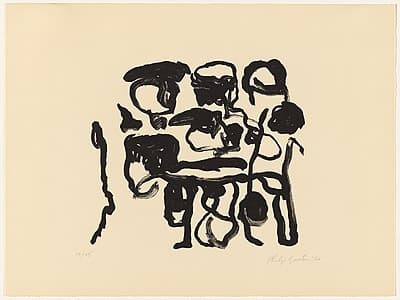
Philip
GUSTON
Canada
1913
–
United States of America
1980
to United States of America 1919
Untitled
1966
planographic
lithograph
on paper
19/25
edition of 25
signed and dated, l.r., pencil, "Philip Guston ‘66"
inscribed, l.l., pencil, "19/25"
53.1 (h)
x 71.2 (w)
cm
Purchased 1985
National Gallery of Australia, Canberra
NGA 1985.1552
- with Irwin Hollander, New York;
- from whom bought by the Australian National Gallery, August 1985
- The Spontaneous Gesture
- National Gallery of Australia 06 Jun 1987 – 13 Sep 1987
- Abstract Expressionism: the National Gallery of Australia celebrates the centenaries of Jackson Pollock and Morris Louis
- 14 Jul 2012 – 24 Feb 2013
Guston rethought his artistic processes during the 1960s. Doubting his aesthetic course, he stopped painting in 1966 to return to the simplicity of drawing, identifying it as a way to strip back his art to its basic components. At this time he also explored lithography and was drawn to the immediacy of the medium. Printmaking allowed him to experiment freely by combining the spontaneity of drawing while preserving the unpredictability of paint. Guston further simplified his art by omitting colour and reducing his forms to simple outlines.
Guston worked directly onto the lithographic stone, producing a variety of abstract marks and simplified figurative forms. In these two lithographs he adopted different approaches. In the first, he used undiluted ink and compacted the composition, the sharp, opaque lines suggesting a massing of figures in a three-dimensional scene. In contrast, the second work features a loose composition of fluid, semi-transparent marks and a largely flattened picture plane; here the elements of the composition swell and explode across the surface of the work. The techniques adopted by Guston during this period were influential for his later paintings.
Caitlin Eyre
Guston rethought his artistic processes during the 1960s. Doubting his aesthetic course, he stopped painting in 1966 to return to the simplicity of drawing, identifying it as a way to strip back his art to its basic components. At this time he also explored lithography and was drawn to the immediacy of the medium. Printmaking allowed him to experiment freely by combining the spontaneity of drawing while preserving the unpredictability of paint. Guston further simplified his art by omitting colour and reducing his forms to simple outlines.
Guston worked directly onto the lithographic stone, producing a variety of abstract marks and simplified figurative forms. In these two lithographs he adopted different approaches. In the first, he used undiluted ink and compacted the composition, the sharp, opaque lines suggesting a massing of figures in a three-dimensional scene. In contrast, the second work features a loose composition of fluid, semi-transparent marks and a largely flattened picture plane; here the elements of the composition swell and explode across the surface of the work. The techniques adopted by Guston during this period were influential for his later paintings.
Caitlin Eyre
Guston rethought his artistic processes during the 1960s. Doubting his aesthetic course, he stopped painting in 1966 to return to the simplicity of drawing, identifying it as a way to strip back his art to its basic components. At this time he also explored lithography and was drawn to the immediacy of the medium. Printmaking allowed him to experiment freely by combining the spontaneity of drawing while preserving the unpredictability of paint. Guston further simplified his art by omitting colour and reducing his forms to simple outlines.
Guston worked directly onto the lithographic stone, producing a variety of abstract marks and simplified figurative forms. In these two lithographs he adopted different approaches. In the first, he used undiluted ink and compacted the composition, the sharp, opaque lines suggesting a massing of figures in a three-dimensional scene. In contrast, the second work features a loose composition of fluid, semi-transparent marks and a largely flattened picture plane; here the elements of the composition swell and explode across the surface of the work. The techniques adopted by Guston during this period were influential for his later paintings.
Caitlin Eyre
